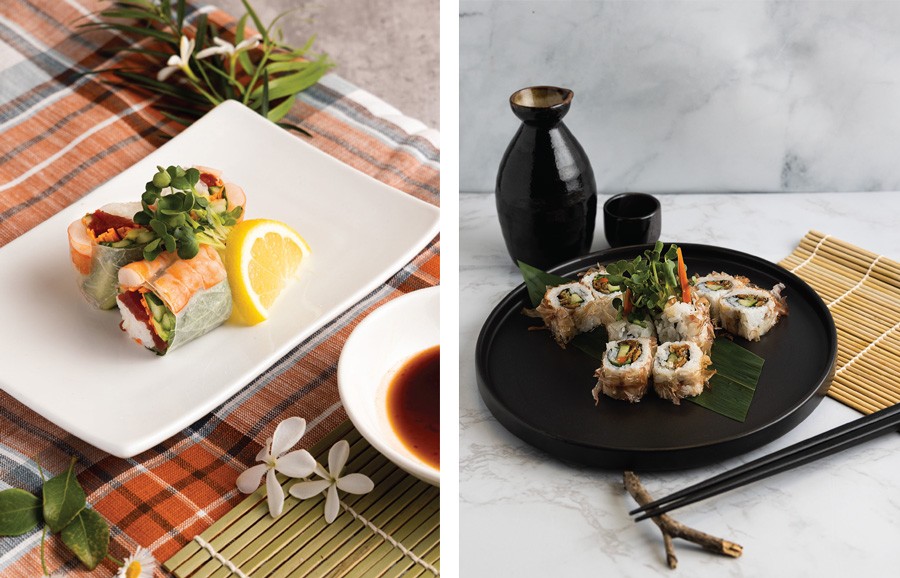Transform your home kitchen into a sushi haven with Let’s Make Sushi! Step-by-Step Tutorials and Essential Recipes for Rolls, Nigiri, Sashimi and More from a Master Sushi Chef. In this comprehensive guide, Chef Andy Matsuda, a master sushi chef and founder of the Sushi Chef Institute, shares his essential techniques and recipes for crafting delicious and properly executed sushi. Whether you’re a beginner or a seasoned home chef, Chef Andy’s step-by-step tutorials and detailed photos make it easy to master the art of rolling rolls, cutting fish, and forming pieces.
Learn how to create various types of sushi, from classic Hosomaki to intricate Futomaki, as well as the traditional cutting technique for nigiri and the five sashimi cuts. Chef Andy even teaches proper Japanese plating and garnishing styles, so you can present your sushi like a pro. With his expert guidance and insights, you’ll develop a deeper appreciation for this traditional cuisine and gain the confidence to make incredible sushi in your own kitchen.
Divided into eight parts, Let’s Make Sushi! covers everything you need to know to get started on your sushi-making journey, including the essential tools and ingredients, preparation techniques, and sauces. And with tips from Chef Andy throughout the book, you’ll be equipped with the knowledge to elevate your sushi-making game to the next level. Don’t miss out on this opportunity to become a sushi master and impress your friends and family with your culinary skills!
Step-by-Step Tutorials from a Master Sushi Chef

Sushi is widely regarded as one of the most challenging Asian cuisines to learn due to its lack of relation to other foods most home cooks typically make. While other cuisines can be contextualized or guessed at, sushi is a unique and unfamiliar territory that requires expert guidance. Writing a cookbook on sushi is therefore an arduous task, but luckily, readers are in good hands with Chef Andy Matsuda.
The author has personally known Chef Andy for over two decades and can attest to his expertise in Japanese cuisine. Despite growing up in cultures that familiarized the author with Thai, Chinese, and French cooking, it wasn’t until Chef Andy provided expert guidance and training that the author was able to truly grasp the art of sushi-making.
Through patient instruction, Chef Andy taught the author the fundamentals of making sushi rice and sushi vinegar, fish selection and preparation, dressing and sauces, and finally, the plated sushi and sashimi. Along the way, Chef Andy shared the history and stories behind the cuisine, fostering a deeper and more meaningful connection to this traditional food.
Let’s Make Sushi! serves as an extension of Chef Andy’s expert guidance, walking readers through the fascinating and delicious world of sushi. With clear instructions and insightful tips, readers will learn the essential techniques and recipes for crafting delicious and authentic sushi in their own homes. By the end of this book, readers will have the confidence to embark on their sushi-making journey and a newfound appreciation for this traditional cuisine. Happy cooking!
What You’ll Learn

Essential Tools & Ingredients

Andy Matusada reminisces about his first sushi tool, a Yanagi knife that he received as a gift from his master in Japan. Initially, he had trouble maintaining the knife and made some mistakes, but he persevered and spent a long time sharpening it.
Matusada still has the knife, and it holds a special place in his heart. When he immigrated to the United States in 1981, the Yanagi knife was the only knife he brought with him. In his book, he encourages his readers to create their own cherished memories with their sushi tools.
Essential Prep

Andy Matusada often gets asked by his students how long it takes to become skilled at making good sushi. He always tells them that building confidence can be achieved in just two years, not only for professionals but anyone with a passion for sushi making.
Andy himself took a long time to perfect the cooking conditions for sushi rice, which is crucial as it serves as the foundation and complements the flavours and textures of sushi.
When he hosts workshops for non-professional cooks, sushi rice is usually the most difficult part. Even his professional students struggle at first, but with his tricks and techniques, it becomes easier.
In his Essential Prep chapter of the book, Andy will share his secrets for making perfect sushi rice and guide readers on sourcing and prepping fish and seafood, including what to look for when buying fresh fish and his preparation techniques for seafood to create delicious rolls, nigiri, and sashimi.
Sushi Rolls

Chef Andy Matsuda learned how to roll sushi from his master when he was 18 years old in Japan. He believes that traditional sushi rolls follow the principle of simplicity, allowing the natural flavor of the ingredients to be enjoyed. However, sushi rolls as they are known today were actually created in America by creative chefs who added more ingredients and sauces to them. Matsuda wants to point out that for Japanese people, sushi refers to nigiri sushi, not rolls.
The creation and popularity of the California Roll opened the doors of the world for sushi, and now there are many sushi lovers around the globe. Sushi has become an international food and is not just limited to Japanese cuisine. It is amazing to see how much sushi has dynamically changed over time, from being street food in Tokyo 300 years ago to becoming a high-end international food today.
Matsuda is overjoyed and filled with pride to witness the exciting evolution of sushi. His book offers the perfect opportunity to learn how to create a wide variety of sushi types, from the ones you’ve enjoyed at restaurants to now being able to make them in the comfort of your own home.
The Sauces

In Japan, the three main sauces are soy sauce, nitsume, and ponzu. However, most of the sauces seen on sushi rolls outside of Japan are not traditional Japanese sauces. Traditional Japanese sauces are mostly vinegar-based, including amazu, nihaizu, sanbaizu, and ponzu.
This is because Japanese cooking is water-based, which means natural flavours are enhanced or extracted with water. Techniques like boiling, simmering, and steaming are all water-based, which is why Japanese cuisine utilizes vinegar sauces to enhance flavours.
It is very important to consider sauces when serving your food and this book explains the best pairings with Japanese sauces and why this is an integral part of any Sushi meal.

Let’s roll with the story of Chef Andy Matsuda – a sushi chef extraordinaire who’s as passionate about food as he is about life! Born near Kobe, Japan in 1956, Chef Matsuda grew up in a family-run restaurant where he learned the art of cooking from a young age.
After working as an apprentice at Genpachi, one of the most famous restaurants in Osaka, Chef Matsuda became a member of a sushi chef organization called Yosei-kai. He then returned to his hometown to help expand the family business before embarking on an exciting new adventure in Los Angeles, California.
Despite starting out as a kitchen assistant in Little Tokyo, Chef Matsuda quickly rose through the ranks to become a chief sushi chef within a week! He’s since worked at some of the finest sushi bars in Santa Monica, Aspen, and New York, and even had the opportunity to learn other cuisines like French, Italian, and Thai while working for major hotels.
But Chef Matsuda’s biggest challenge came when he was diagnosed with colon cancer at the age of 36. After four years of intensive treatments and self-reflection, he began to understand the relationship between food, health, people, and the environment. With a renewed appreciation for life, he wanted to give back to American society and so, in 2002, he started the Sushi Chef Institute in downtown Los Angeles (now located in Torrance, California).
Through the institute, Chef Matsuda has taught beginners and professional chefs from all over the world, sharing his knowledge of sushi in an accurate and comprehensive manner. He believes that by teaching his philosophy of gratitude towards nature, family, and society, he can inspire people from all walks of life to discover new aspects of sushi and gain a greater interest in this field.







































